From Wikipedia, the free encyclopedia
In group theory, a word is any written product of group elements and their inverses. For example, if x, y and z are elements of a group G, then xy, z−1xzz and y−1zxx−1yz−1 are words in the set {x, y, z}. Two different words may evaluate to the same value in G,[1] or even in every group.[2] Words play an important role in the theory of free groups and presentations, and are central objects of study in combinatorial group theory.
Definitions[edit]
Let G be a group, and let S be a subset of G. A word in S is any expression of the form
where s1,…,sn are elements of S, called generators, and each εi is ±1. The number n is known as the length of the word.
Each word in S represents an element of G, namely the product of the expression. By convention, the unique[3] identity element can be represented by the empty word, which is the unique word of length zero.
Notation[edit]
When writing words, it is common to use exponential notation as an abbreviation. For example, the word
could be written as
This latter expression is not a word itself—it is simply a shorter notation for the original.
When dealing with long words, it can be helpful to use an overline to denote inverses of elements of S. Using overline notation, the above word would be written as follows:
Reduced words[edit]
Any word in which a generator appears next to its own inverse (xx−1 or x−1x) can be simplified by omitting the redundant pair:
This operation is known as reduction, and it does not change the group element represented by the word. Reductions can be thought of as relations (defined below) that follow from the group axioms.
A reduced word is a word that contains no redundant pairs. Any word can be simplified to a reduced word by performing a sequence of reductions:
The result does not depend on the order in which the reductions are performed.
A word is cyclically reduced if and only if every cyclic permutation of the word is reduced.
Operations on words[edit]
The product of two words is obtained by concatenation:
Even if the two words are reduced, the product may not be.
The inverse of a word is obtained by inverting each generator, and reversing the order of the elements:
The product of a word with its inverse can be reduced to the empty word:
You can move a generator from the beginning to the end of a word by conjugation:
Generating set of a group[edit]
A subset S of a group G is called a generating set if every element of G can be represented by a word in S.
When S is not a generating set for G, the set of elements represented by words in S is a subgroup of G, known as the subgroup of G generated by S and usually denoted 
Normal forms[edit]
A normal form for a group G with generating set S is a choice of one reduced word in S for each element of G. For example:
- The words 1, i, j, ij are a normal form for the Klein four-group with S = {i, j} and 1 representing the empty word (the identity element for the group).
- The words 1, r, r2, …, rn-1, s, sr, …, srn-1 are a normal form for the dihedral group Dihn with S = {s, r} and 1 as above.
- The set of words of the form xmyn for m,n ∈ Z are a normal form for the direct product of the cyclic groups ⟨x⟩ and ⟨y⟩ with S = {x, y}.
- The set of reduced words in S are the unique normal form for the free group over S.
Relations and presentations[edit]
If S is a generating set for a group G, a relation is a pair of words in S that represent the same element of G. These are usually written as equations, e.g.
A set 



For example, the Klein four-group can be defined by the presentation
Here 1 denotes the empty word, which represents the identity element.
Free groups[edit]
If S is any set, the free group over S is the group with presentation 
See also[edit]
- Word problem (mathematics)
- Word problem for groups
Notes[edit]
- ^ for example, fdr1 and r1fc in the group of square symmetries
- ^ for example, xy and xzz−1y
- ^ Uniqueness of identity element and inverses
References[edit]
- Epstein, David; Cannon, J. W.; Holt, D. F.; Levy, S. V. F.; Paterson, M. S.; Thurston, W. P. (1992). Word Processing in Groups. AK Peters. ISBN 0-86720-244-0..
- Novikov, P. S. (1955). «On the algorithmic unsolvability of the word problem in group theory». Trudy Mat. Inst. Steklov (in Russian). 44: 1–143.
- Robinson, Derek John Scott (1996). A course in the theory of groups. Berlin: Springer-Verlag. ISBN 0-387-94461-3.
- Rotman, Joseph J. (1995). An introduction to the theory of groups. Berlin: Springer-Verlag. ISBN 0-387-94285-8.
- Schupp, Paul E; Lyndon, Roger C. (2001). Combinatorial group theory. Berlin: Springer. ISBN 3-540-41158-5.
- Solitar, Donald; Magnus, Wilhelm; Karrass, Abraham (2004). Combinatorial group theory: presentations of groups in terms of generators and relations. New York: Dover. ISBN 0-486-43830-9.
- Stillwell, John (1993). Classical topology and combinatorial group theory. Berlin: Springer-Verlag. ISBN 0-387-97970-0.
В теории групп, слово — это любое письменное произведение элементов группы и их обратных значений. Например, если x, y и z являются элементами группы G, то xy, zxzz и yzxxyz — слова из множества {x, y, z}. Два разных слова могут давать одно и то же значение в G или даже в каждой группе. Слова играют важную роль в теории свободных групп и представлений и являются центральными объектами изучения комбинаторной теории групп.
Содержание
- 1 Определение
- 2 Обозначение
- 3 Слова и представления
- 4 Сокращенные слова
- 5 Нормальные формы
- 6 Операции над словами
- 7 Проблема со словами
- 8 Примечания
- 9 Ссылки
Определение
Пусть G — группа, а S — подмножество группы G. Слово в S — это любое выражение формы
- s 1 ε 1 s 2 ε 2 ⋯ sn ε N { Displaystyle s_ {1} ^ { varepsilon _ {1}} s_ {2} ^ { varepsilon _ {2}} cdots s_ {n} ^ { varepsilon _ {n}}}
где s 1,…, s n — элементы S, и каждый ε i равен ± 1. Число n известно как длина слова.
Каждое слово в S представляет собой элемент G, а именно продукт выражения. По соглашению, identity (уникальный) элемент может быть представлен пустым словом, которое является уникальным словом нулевой длины.
Нотация
При написании слов обычно используется экспоненциальная нотация в качестве сокращения. Например, слово
- xxy — 1 zyzzzx — 1 x — 1 { displaystyle xxy ^ {- 1} zyzzzx ^ {- 1} x ^ {- 1} ,}
можно записать как
- х 2 у — 1 zyz 3 х — 2. { displaystyle x ^ {2} y ^ {- 1} zyz ^ {3} x ^ {- 2}. ,}
Это последнее выражение не является само словом — это просто сокращенное обозначение оригинала..
При работе с длинными словами может быть полезно использовать надстрочный знак для обозначения инверсий элементов S. Используя надстрочную нотацию, указанное выше слово будет записано следующим образом:
- x 2 y ¯ zyz 3 x ¯ 2. { displaystyle x ^ {2} { overline {y}} zyz ^ {3} { overline {x}} ^ {2}. ,}
Слова и презентации
Подмножество S группы G называется порождающим набором, если каждый элемент G может быть представлен словом в S. Если S является порождающим набором, отношение представляет собой пару слов в S, которые представляют один и тот же элемент G. Обычно они записываются в виде уравнений, например х — 1 у х = у 2. { displaystyle x ^ {- 1} yx = y ^ {2}. ,}




Например, четырехгруппа Клейна может быть определена представлением
- ⟨i, j ∣ i 2 = 1, j 2 = 1, i j = j i⟩. { displaystyle langle i, j mid i ^ {2} = 1, , j ^ {2} = 1, , ij = ji rangle.}
Здесь 1 обозначает пустое слово, которое представляет элемент идентичности.
Когда S не является порождающим набором для G, набор элементов, представленных словами в S, является подгруппой группы G. Это известно как подгруппа группы G, генерируемая S, обычно обозначается как ⟨S⟩ { displaystyle langle S rangle}
Сокращенные слова
Любое слово, в котором генератор появляется рядом с его собственным обратным (xx или xx), можно упростить, исключив избыточная пара:
- y — 1 zxx — 1 y ⟶ y — 1 zy. { displaystyle y ^ {- 1} zxx ^ {- 1} y ; ; longrightarrow ; ; y ^ {- 1} zy.}
Эта операция известна как сокращение, и это не меняет элемент группы, представленный словом. (Редукции можно рассматривать как отношения, следующие из групповых аксиом.)
A сокращенное слово — это слово, не содержащее лишних пар. Любое слово можно упростить до сокращенного слова, выполнив последовательность сокращений:
- x z y — 1 x x — 1 y z — 1 z z — 1 y z ⟶ x y z. { displaystyle xzy ^ {- 1} xx ^ {- 1} yz ^ {- 1} zz ^ {- 1} yz ; ; longrightarrow ; ; xyz.}
Результат не зависит от порядок, в котором выполняются сокращения.
Если S — любой набор, свободная группа над S — это группа с представлением ⟨S ∣⟩ { displaystyle langle S mid ; rangle}
Слово циклически сокращается тогда и только тогда, когда каждая циклическая перестановка слова сокращено.
Нормальные формы
A нормальные формы для группы G с порождающим набором S — это выбор одного сокращенного слова в S для каждого элемента G. Например:
- Слова 1, i, j, ij являются нормальной формой для четырехгруппы Клейна.
- Слова 1, r, r,…, r, s, sr,…, sr являются нормальной формой для группы диэдра Dih n.
- Набор сокращенных слов в S является нормальной формой для свободной группы над S.
- Набор слов формы xy для m, n ∈ Z представляют собой нормальную форму для прямого произведения циклических групп 〈x〉 и 〈y〉.
Операции над словами
произведение двух слов получается конкатенацией:
- (xzyz — 1) (zy — 1 x — 1 y) = xzyz — 1 zy — 1 x — 1 y. { displaystyle left (xzyz ^ {- 1} right) left (zy ^ {- 1} x ^ {- 1} y right) = xzyz ^ {- 1} zy ^ {- 1} x ^ { -1} y.}
Даже если два слова сократить, продукта может не быть.
инверсия слова получается путем инвертирования каждого генератора и переключения порядка элементов:
- (zy — 1 x — 1 y) — 1 = y — 1 xyz — 1. { displaystyle left (zy ^ {- 1} x ^ {- 1} y right) ^ {- 1} = y ^ {- 1} xyz ^ {- 1}.}
Произведение слова с обратным ему можно свести к пустому слову:
- zy — 1 x — 1 yy — 1 xyz — 1 = 1. { displaystyle zy ^ {- 1} x ^ {- 1} y ; y ^ { -1} xyz ^ {- 1} = 1.}
Вы можете переместить генератор из начала в конец слова с помощью спряжения :
- x — 1 (xy — 1 z — 1 yz) х = у — 1 z — 1 yzx. { displaystyle x ^ {- 1} left (xy ^ {- 1} z ^ {- 1} yz right) x = y ^ {- 1} z ^ {- 1} yzx.}
Слово проблема
Учитывая представление ⟨S ∣ R⟩ { displaystyle langle S mid { mathcal {R}} rangle}
Примечания
Ссылки
- Эпштейн, Дэвид ; Кэннон, JW ; Холт, Д.Ф.; Леви, SVF; Патерсон, MS ; Thurston, WP (1992). Обработка текстов в группах. AK Peters. ISBN 0-86720-244-0 ..
- Новиков PS (1955). «Об алгоритмической неразрешимости проблемы слова в теории групп», Труды Матем. Ин-та Стеклова. Ян). 44 : 1–143. CS1 maint: ref = harv (link )
- Робинсон, Дерек Джон Скотт (1996). Курс теории групп. Берлин: Springer- Verlag. ISBN 0-387-94461-3 .
- Rotman, Joseph J. (1995). Введение в теорию групп. Berlin: Springer-Verlag. ISBN 0-387-94285-8 .
- Шупп, Пол Э ; Линдон, Роджер К. (2001). Комбинаторная теория групп. Берлин: Springer. ISBN 3-540-41158-5 .
- Солитэр, Дональд ; Магнус, Вильгельм ; Каррасс, Абрахам (2004). Комбинаторная теория групп: представления групп в терминах генераторы и отношения. Нью-Йорк: Довер. ISBN 0-486-43830-9 .
- Стиллвелл, Джон (1993). Классическая топология и комбинаторная теория групп. Берлин: Springer-Verlag. ISBN 0-387-97970-0 .
Слайд 1
The Word-Group Theory
Lecture 4. Part 2
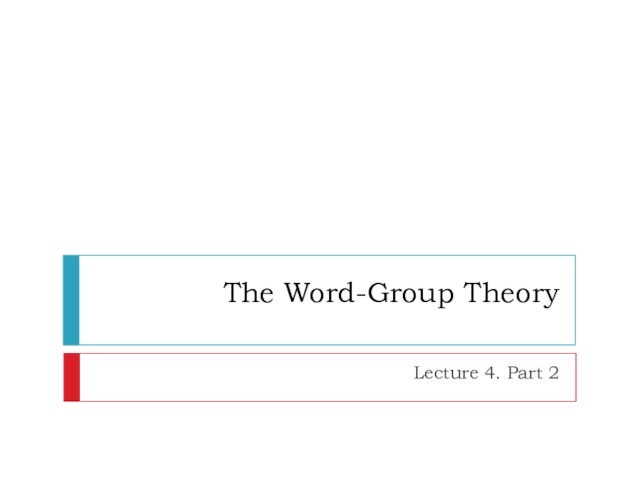
Слайд 2
Lecture outline
Syntactic relations.
The definition and general characteristics.
Classification of
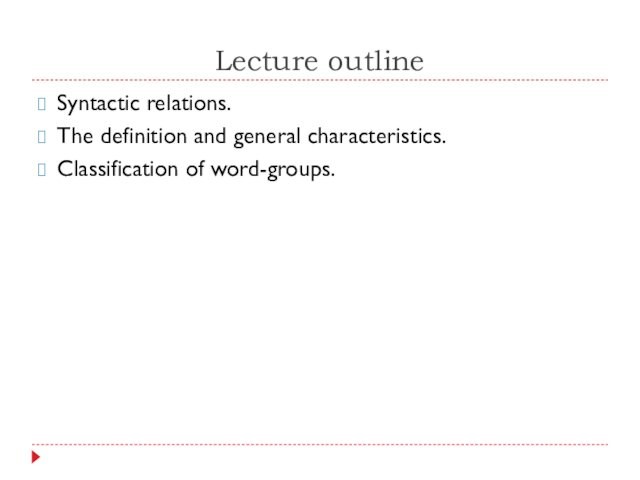
word-groups.
Слайд 3
The syntactic notions
Syntactic relations: the syntagmatic (linear) relations
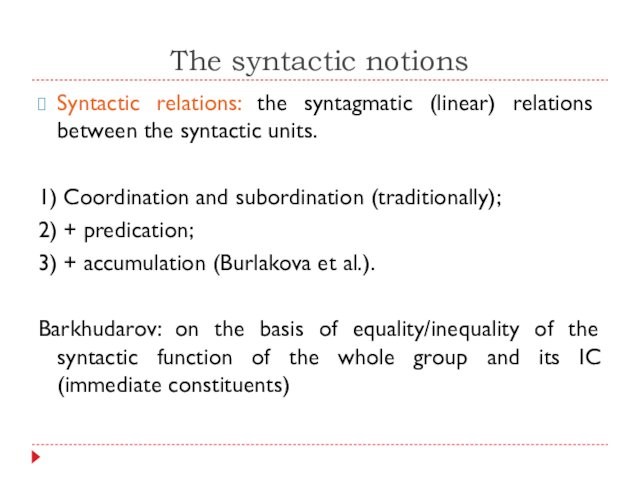
between the syntactic units.
1) Coordination and subordination (traditionally);
2) +
predication;
3) + accumulation (Burlakova et al.).
Barkhudarov: on the basis of
equality/inequality of the syntactic function of the whole group and its IC (immediate constituents)
Слайд 4
The syntactic relations
Coordination (independence):
word group, sentence, text;
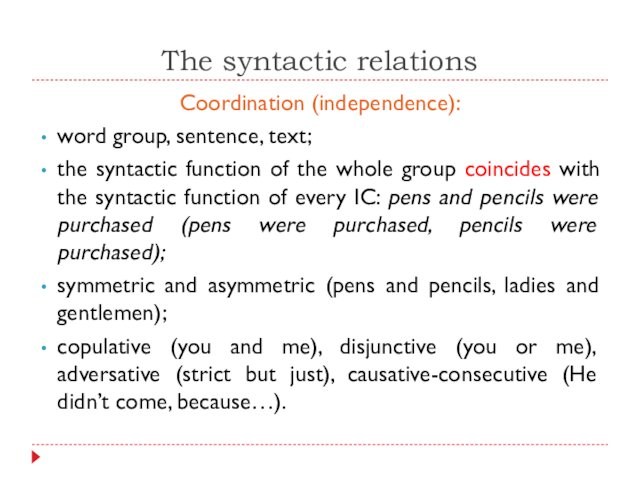
the syntactic function of the whole group coincides with
the syntactic function of every IC: pens and pencils were
purchased (pens were purchased, pencils were purchased);
symmetric and asymmetric (pens and pencils, ladies and gentlemen);
copulative (you and me), disjunctive (you or me), adversative (strict but just), causative-consecutive (He didn’t come, because…).
Слайд 5
The syntactic relations
Subordination (dependence, difference linguistic rank):
word-group and
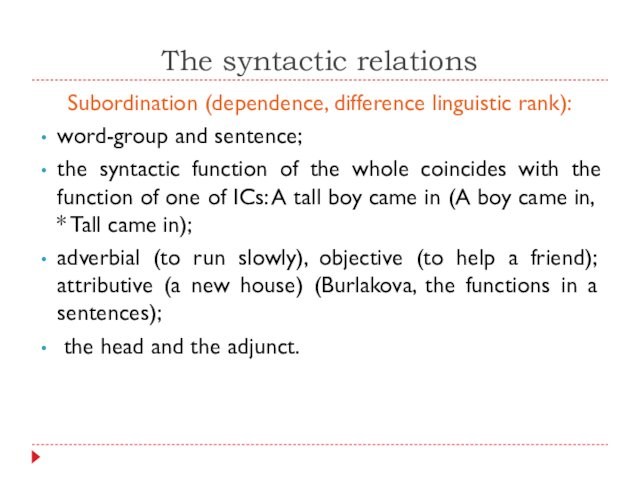
sentence;
the syntactic function of the whole coincides with the
function of one of ICs: A tall boy came in
(A boy came in, * Tall came in);
adverbial (to run slowly), objective (to help a friend); attributive (a new house) (Burlakova, the functions in a sentences);
the head and the adjunct.
Слайд 6
Syntactic relations
Predication (interdependence):
the syntactic function of the whole
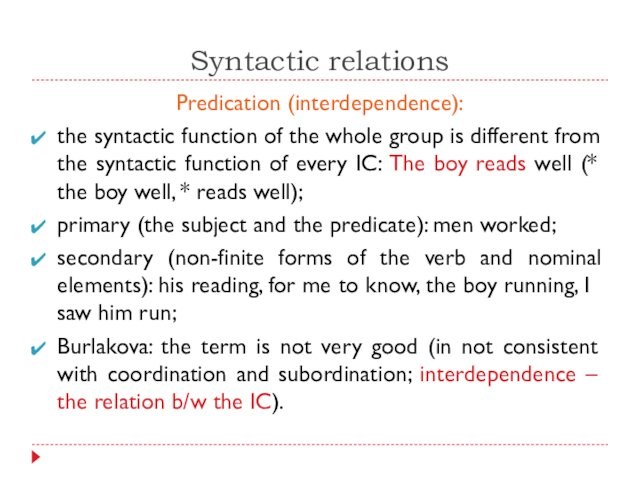
group is different from the syntactic function of every
IC: The boy reads well (* the boy well, *
reads well);
primary (the subject and the predicate): men worked;
secondary (non-finite forms of the verb and nominal elements): his reading, for me to know, the boy running, I saw him run;
Burlakova: the term is not very good (in not consistent with coordination and subordination; interdependence – the relation b/w the IC).
Слайд 7
Syntactic relations
Accumulative
The relations b/w the constituents can be
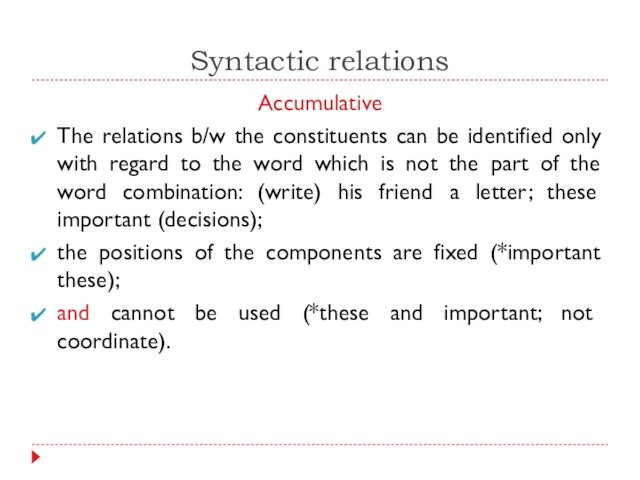
identified only with regard to the word which is
not the part of the word combination: (write) his friend
a letter; these important (decisions);
the positions of the components are fixed (*important these);
and cannot be used (*these and important; not coordinate).
Слайд 8
The word-group. The definition.
the basic unit of syntax
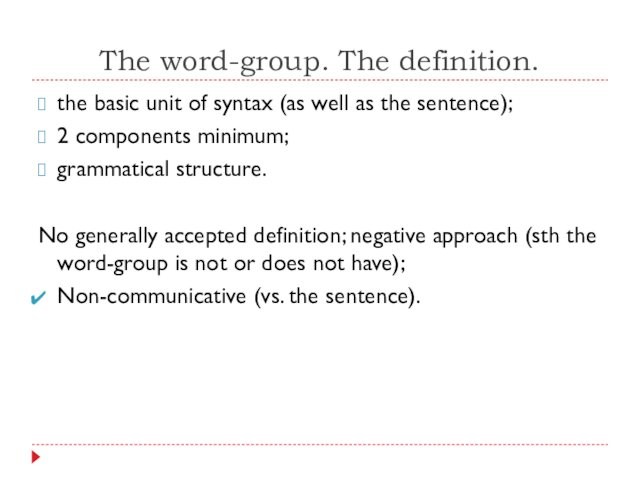
(as well as the sentence);
2 components minimum;
grammatical structure.
No generally
accepted definition; negative approach (sth the word-group is not or
does not have);
Non-communicative (vs. the sentence).
Слайд 9
The views on word-groups
Broad (every syntactically organized group,
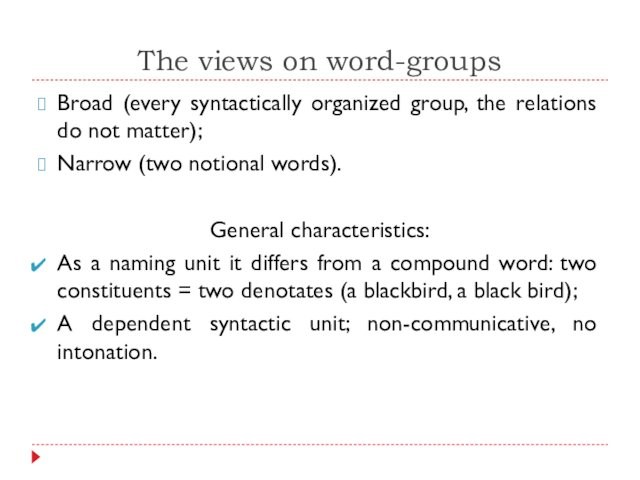
the relations do not matter);
Narrow (two notional words).
General characteristics:
As
a naming unit it differs from a compound word: two
constituents = two denotates (a blackbird, a black bird);
A dependent syntactic unit; non-communicative, no intonation.
Слайд 10
The broad view: syntagmatic groupings
(by Blokh)
Notional words
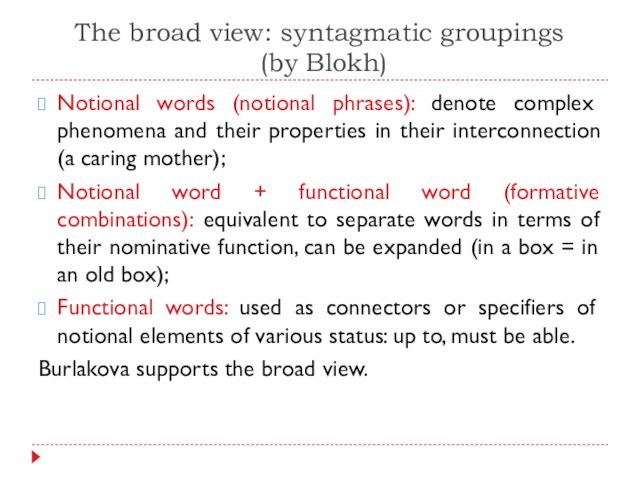
(notional phrases): denote complex phenomena and their properties in
their interconnection (a caring mother);
Notional word + functional word (formative
combinations): equivalent to separate words in terms of their nominative function, can be expanded (in a box = in an old box);
Functional words: used as connectors or specifiers of notional elements of various status: up to, must be able.
Burlakova supports the broad view.
Слайд 11
The notional phrases (classification)
Equipotent (words are related on
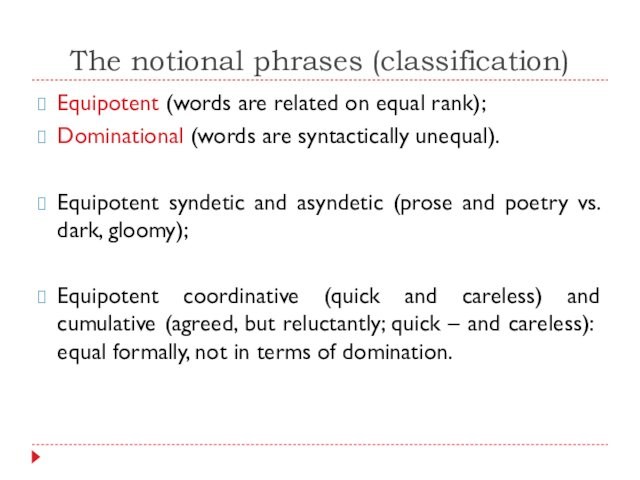
equal rank);
Dominational (words are syntactically unequal).
Equipotent syndetic and asyndetic
(prose and poetry vs. dark, gloomy);
Equipotent coordinative (quick and careless)
and cumulative (agreed, but reluctantly; quick – and careless): equal formally, not in terms of domination.
Слайд 12
Dominational connection (Blokh)
The principal (dominating) – kernel, kernel
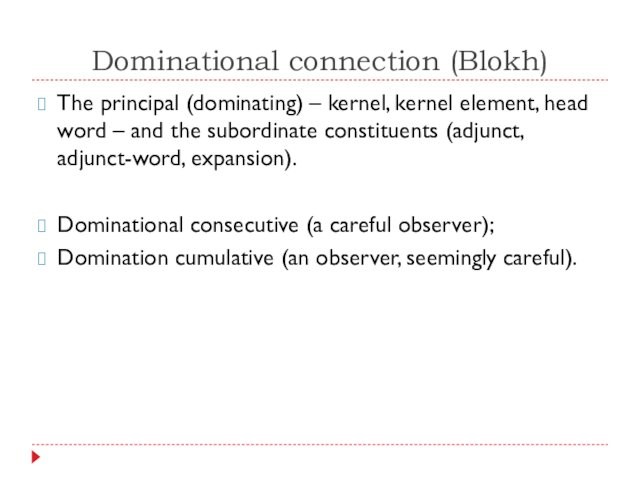
element, head word – and the subordinate constituents (adjunct,
adjunct-word, expansion).
Dominational consecutive (a careful observer);
Domination cumulative (an observer, seemingly
careful).
Слайд 13
Dominational connection (Blokh)
Dominational bilateral (reciprocal, two-way): predicative (complete
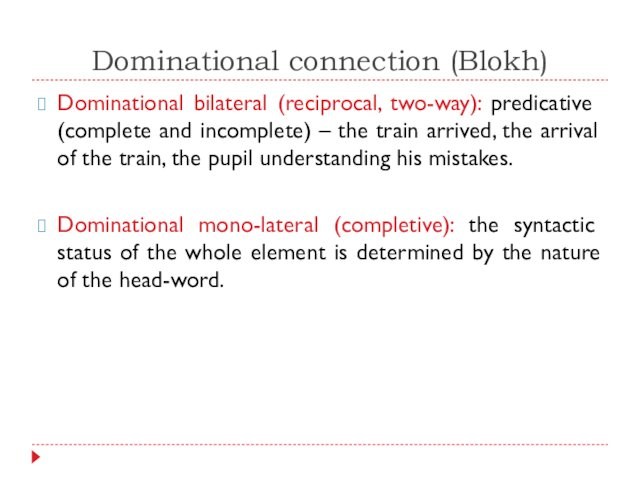
and incomplete) – the train arrived, the arrival of
the train, the pupil understanding his mistakes.
Dominational mono-lateral (completive): the
syntactic status of the whole element is determined by the nature of the head-word.
Слайд 14
Dominational connection (Blokh)
Dominational completive connection: objective and qualifying.
Objective:
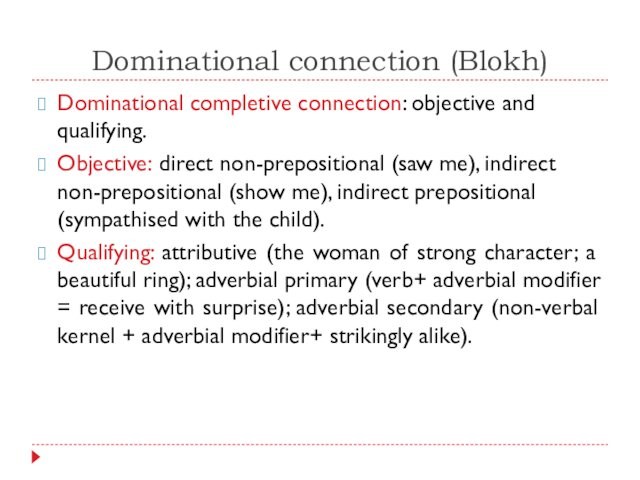
direct non-prepositional (saw me), indirect non-prepositional (show me), indirect
prepositional (sympathised with the child).
Qualifying: attributive (the woman of strong
character; a beautiful ring); adverbial primary (verb+ adverbial modifier = receive with surprise); adverbial secondary (non-verbal kernel + adverbial modifier+ strikingly alike).
Слайд 15
The narrow view (Barkhudarov)
Word-group (phrase) is a group
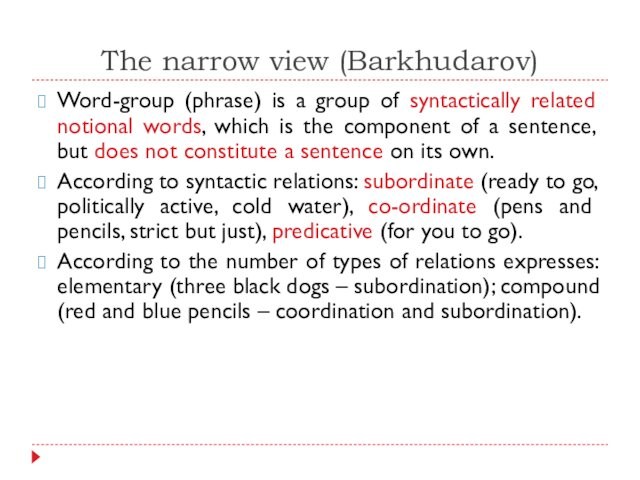
of syntactically related notional words, which is the component
of a sentence, but does not constitute a sentence on
its own.
According to syntactic relations: subordinate (ready to go, politically active, cold water), co-ordinate (pens and pencils, strict but just), predicative (for you to go).
According to the number of types of relations expresses: elementary (three black dogs – subordination); compound (red and blue pencils – coordination and subordination).
Слайд 16
The subordinate phrase
Syntactically unequal;
The head and the adjunct.
Types:
The
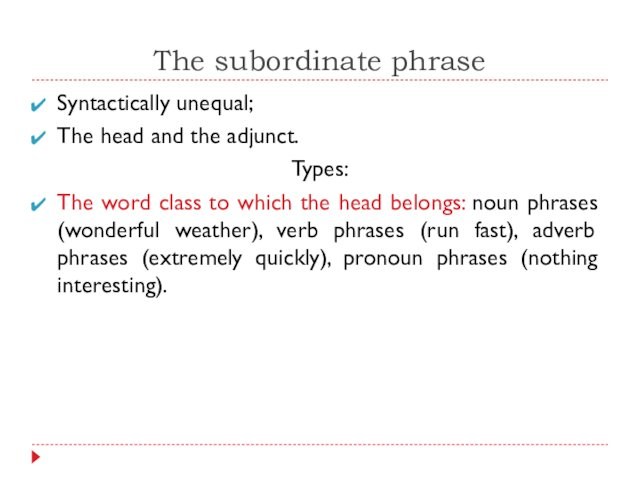
word class to which the head belongs: noun phrases
(wonderful weather), verb phrases (run fast), adverb phrases (extremely quickly),
pronoun phrases (nothing interesting).
Слайд 17
The subordinate phrase: types
ICs represented with a word
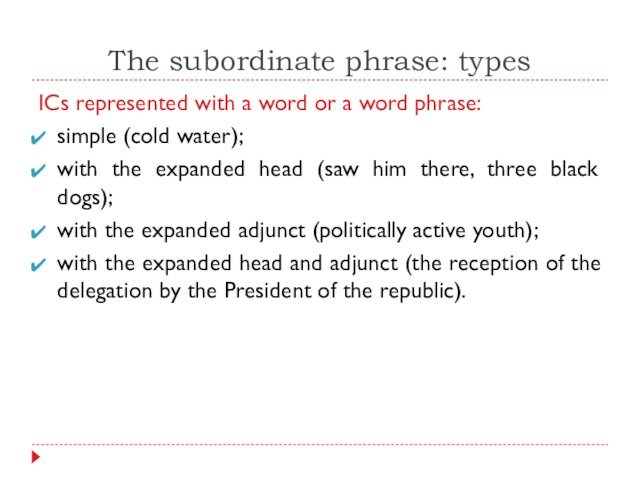
or a word phrase:
simple (cold water);
with the
expanded head (saw him there, three black dogs);
with the
expanded adjunct (politically active youth);
with the expanded head and adjunct (the reception of the delegation by the President of the republic).
Слайд 18
The subordinate phrase: types
ICs separated / non-separated from
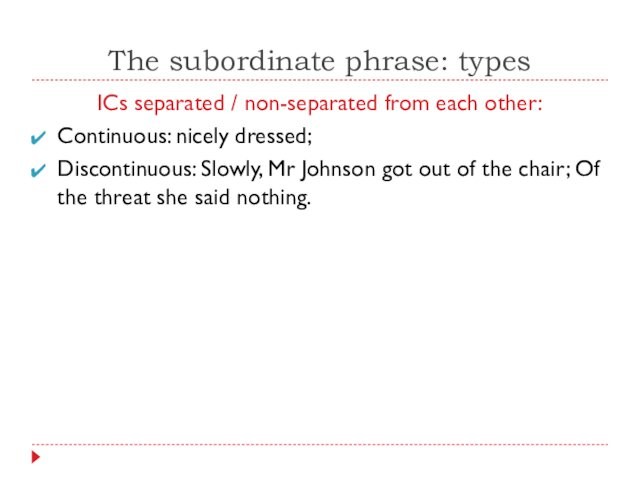
each other:
Continuous: nicely dressed;
Discontinuous: Slowly, Mr Johnson got
out of the chair; Of the threat she said nothing.
Слайд 19
Noun Phrases
The place of the adjunct:
Noun phrases with
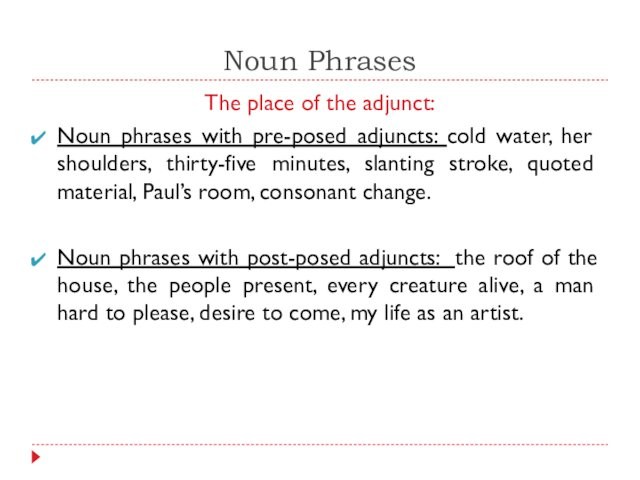
pre-posed adjuncts: cold water, her shoulders, thirty-five minutes, slanting
stroke, quoted material, Paul’s room, consonant change.
Noun phrases with post-posed
adjuncts: the roof of the house, the people present, every creature alive, a man hard to please, desire to come, my life as an artist.
Слайд 20
Verb Phrases
According to the class of the verb:
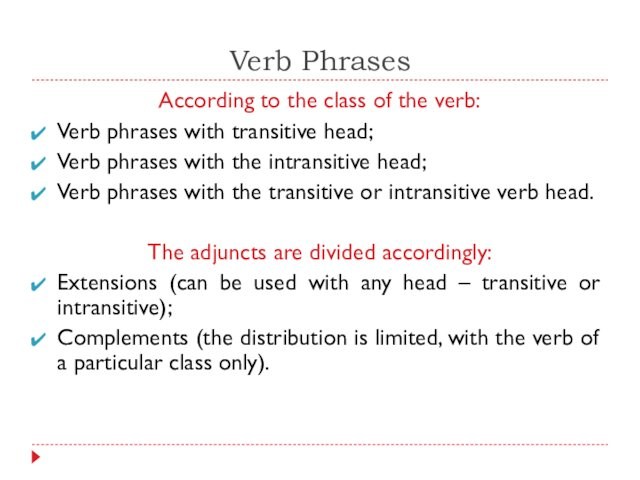
Verb phrases with transitive head;
Verb phrases with the intransitive
head;
Verb phrases with the transitive or intransitive verb head.
The adjuncts
are divided accordingly:
Extensions (can be used with any head – transitive or intransitive);
Complements (the distribution is limited, with the verb of a particular class only).
Слайд 21
Verb phrases
Adjuncts (complements):
object complements (transitive head):
prepositional and non-prepositional
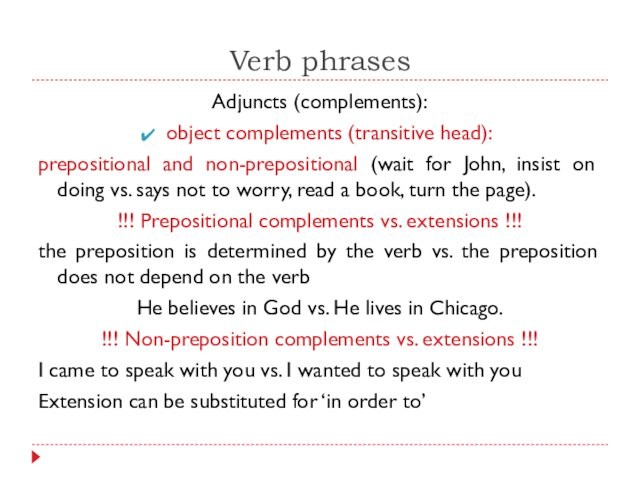
(wait for John, insist on doing vs. says not
to worry, read a book, turn the page).
!!! Prepositional complements
vs. extensions !!!
the preposition is determined by the verb vs. the preposition does not depend on the verb
He believes in God vs. He lives in Chicago.
!!! Non-preposition complements vs. extensions !!!
I came to speak with you vs. I wanted to speak with you
Extension can be substituted for ‘in order to’
Слайд 22
Verb phrases
Adjuncts (complements):
qualifying complements (intransitive head): rise slowly:
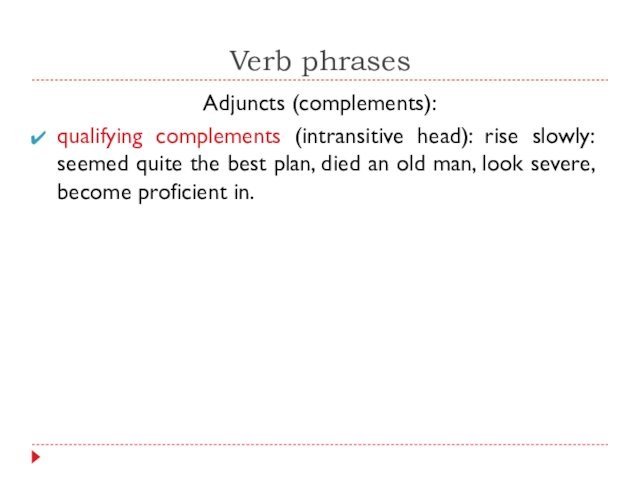
seemed quite the best plan, died an old man,
look severe, become proficient in.
Слайд 23
Verb phrases
According to the number and type of
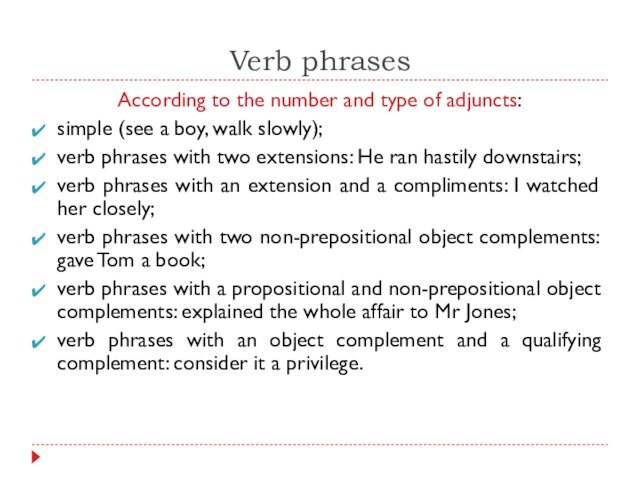
adjuncts:
simple (see a boy, walk slowly);
verb phrases with two
extensions: He ran hastily downstairs;
verb phrases with an extension and
a compliments: I watched her closely;
verb phrases with two non-prepositional object complements: gave Tom a book;
verb phrases with a propositional and non-prepositional object complements: explained the whole affair to Mr Jones;
verb phrases with an object complement and a qualifying complement: consider it a privilege.
Слайд 24
Other types of phrases
Adjective phrases:
Politically active;
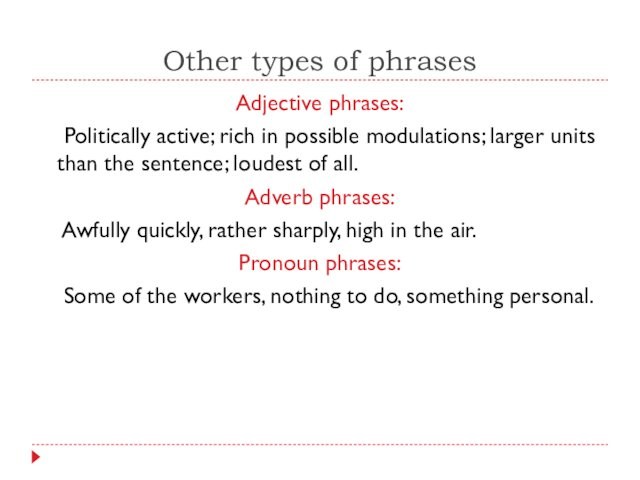
rich in possible modulations; larger units than the sentence;
loudest of all.
Adverb phrases:
Awfully quickly, rather sharply, high
in the air.
Pronoun phrases:
Some of the workers, nothing to do, something personal.
Слайд 25
Coordinate phrases
According to the means used to connect
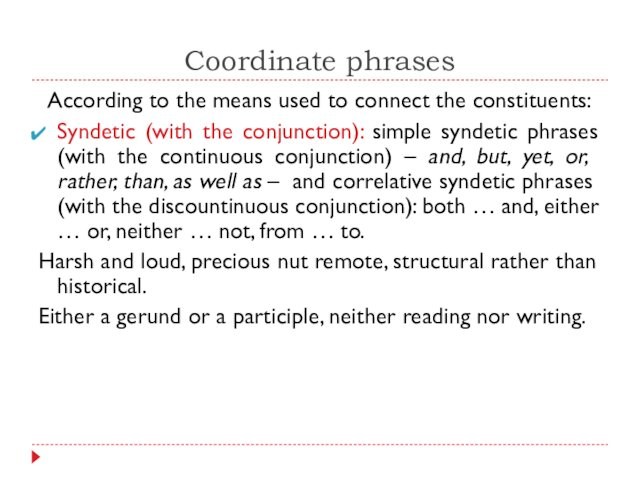
the constituents:
Syndetic (with the conjunction): simple syndetic phrases (with
the continuous conjunction) – and, but, yet, or, rather, than,
as well as – and correlative syndetic phrases (with the discountinuous conjunction): both … and, either … or, neither … not, from … to.
Harsh and loud, precious nut remote, structural rather than historical.
Either a gerund or a participle, neither reading nor writing.
Слайд 26
Coordinate phrases
According to the means used to connect
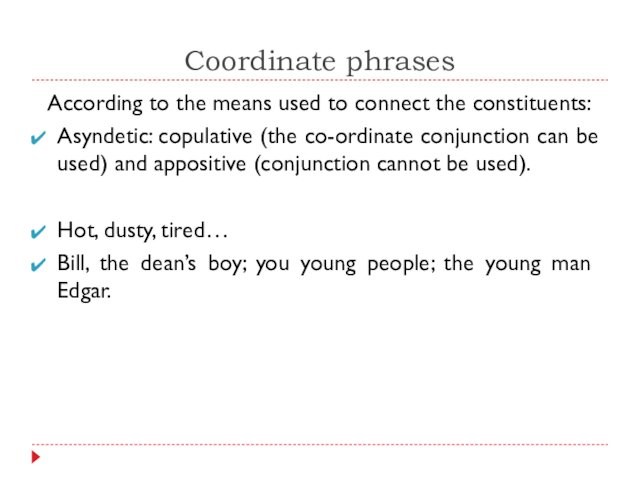
the constituents:
Asyndetic: copulative (the co-ordinate conjunction can be used)
and appositive (conjunction cannot be used).
Hot, dusty, tired…
Bill, the dean’s
boy; you young people; the young man Edgar.
Слайд 27
Predicative phrases
The combinations of the subject and the
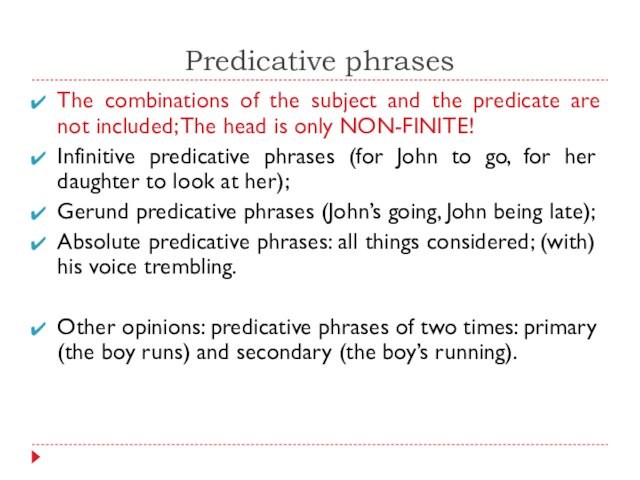
predicate are not included; The head is only NON-FINITE!
Infinitive
predicative phrases (for John to go, for her daughter to
look at her);
Gerund predicative phrases (John’s going, John being late);
Absolute predicative phrases: all things considered; (with) his voice trembling.
Other opinions: predicative phrases of two times: primary (the boy runs) and secondary (the boy’s running).
Слайд 28
Conclusion
The word-group is a combination of at least
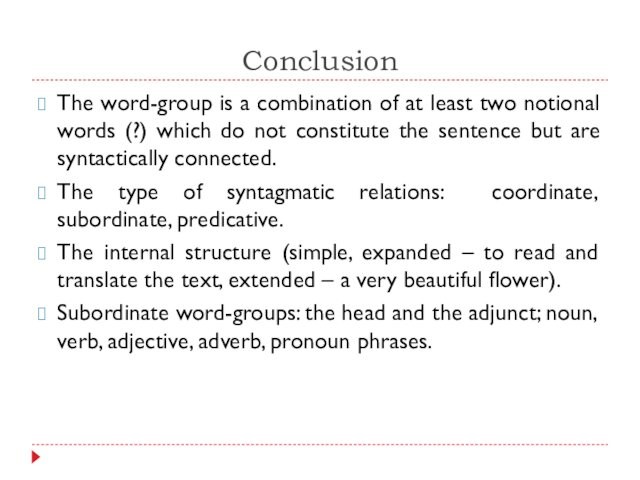
two notional words (?) which do not constitute the
sentence but are syntactically connected.
The type of syntagmatic relations: coordinate,
subordinate, predicative.
The internal structure (simple, expanded – to read and translate the text, extended – a very beautiful flower).
Subordinate word-groups: the head and the adjunct; noun, verb, adjective, adverb, pronoun phrases.
-
Скачать презентацию (0.11 Мб)
-
7 загрузок -
0.0 оценка
Ваша оценка презентации
Оцените презентацию по шкале от 1 до 5 баллов
- 1
- 2
- 3
- 4
- 5
Комментарии
Добавить свой комментарий
Аннотация к презентации
Посмотреть и скачать бесплатно презентацию по теме «The word-group theory», состоящую из 28 слайдов. Размер файла 0.11 Мб. Каталог презентаций, школьных уроков, студентов, а также для детей и их родителей.
-
Формат
pptx (powerpoint)
-
Количество слайдов
28
-
Слова
-
Конспект
Отсутствует
Содержание
-
Слайд 1
The Word-Group Theory
Lecture 9
-
Слайд 2
Lecture outline
Syntactic relations.
The definition and general characteristics.
Classification of word-groups. -
Слайд 3
The syntactic notions
Syntactic relations: the syntagmatic (linear) relations between the syntactic units.
1) Coordination and subordination (traditionally);
2) + predication;
3) + accumulation (Burlakova et al.).Barkhudarov: on the basis of equality/inequality of the syntactic function of the whole group and its IC (immediate constituents)
-
Слайд 4
The syntactic relations
Coordination (independence):
word group, sentence, text;
the syntactic function of the whole group coincides with the syntactic function of every IC: pens and pencils were purchased (pens were purchased, pencils were purchased);
symmetric and asymmetric (pens and pencils, ladies and gentlemen);
copulative (you and me), disjunctive (you or me), adversative (strict but just), causative-consecutive (He didn’t come, because…). -
Слайд 5
Subordination (dependence, difference linguistic rank):
word-group and sentence;
the syntactic function of the whole coincides with the function of one of ICs: A tall boy came in (A boy came in, * Tall came in);
adverbial (to run slowly), objective (to help a friend); attributive (a new house) (Burlakova, the functions in a sentences);
the head and the adjunct. -
Слайд 6
Syntactic relations
Predication (interdependence):
the syntactic function of the whole group is different from the syntactic function of every IC: The boy reads well (* the boy well, * reads well);
primary (the subject and the predicate): men worked;
secondary (non-finite forms of the verb and nominal elements): his reading, for me to know, the boy running, I saw him run;
Burlakova: the term is not very good (in not consistent with coordination and subordination; interdependence – the relation b/w the IC). -
Слайд 7
Accumulative
The relations b/w the constituents can be identified only with regard to the word which is not the part of the word combination: (write) his friend a letter; these important (decisions);
the positions of the components are fixed (*important these);
and cannot be used (*these and important; not coordinate). -
Слайд 8
The word-group. The definition.
the basic unit of syntax (as well as the sentence);
2 components minimum;
grammatical structure.No generally accepted definition; negative approach (sth the word-group is not or does not have);
Non-communicative (vs. the sentence). -
Слайд 9
The views on word-groups
Broad (every syntactically organized group, the relations do not matter);
Narrow (two notional words).General characteristics:
As a naming unit it differs from a compound word: two constituents = two denotates (a blackbird, a black bird);
A dependent syntactic unit; non-communicative, no intonation. -
Слайд 10
The broad view: syntagmatic groupings (by Blokh)
Notional words (notional phrases): denote complex phenomena and their properties in their interconnection (a caring mother);
Notional word + functional word (formative combinations): equivalent to separate words in terms of their nominative function, can be expanded (in a box = in an old box);
Functional words: used as connectors or specifiers of notional elements of various status: up to, must be able.
Burlakova supports the broad view. -
Слайд 11
The notional phrases (classification)
Equipotent (words are related on equal rank);
Dominational(words are syntactically unequal).Equipotent syndetic and asyndetic (prose and poetry vs. dark, gloomy);
Equipotent coordinative (quick and careless) and cumulative (agreed, but reluctantly; quick – and careless): equal formally, not in terms of domination.
-
Слайд 12
Dominational connection (Blokh)
The principal (dominating) – kernel, kernel element, head word – and the subordinate constituents (adjunct, adjunct-word, expansion).
Dominational consecutive (a careful observer);
Domination cumulative (an observer, seemingly careful). -
Слайд 13
Dominational bilateral (reciprocal, two-way): predicative (complete and incomplete) – the train arrived, the arrival of the train, the pupil understanding his mistakes.
Dominational mono-lateral (completive): the syntactic status of the whole element is determined by the nature of the head-word.
-
Слайд 14
Dominational completive connection: objective and qualifying.
Objective: direct non-prepositional (saw me), indirect non-prepositional (show me), indirect prepositional (sympathised with the child).
Qualifying: attributive (the woman of strong character; a beautiful ring); adverbial primary (verb+ adverbial modifier = receive with surprise); adverbial secondary (non-verbal kernel + adverbial modifier+ strikingly alike). -
Слайд 15
The narrow view (Barkhudarov)
Word-group (phrase) is a group of syntactically relatednotional words, which is the component of a sentence, but does not constitute a sentence on its own.
According to syntactic relations: subordinate (ready to go, politically active, cold water), co-ordinate (pens and pencils, strict but just), predicative (for you to go).
According to the number of types of relations expresses: elementary (three black dogs – subordination); compound (red and blue pencils – coordination and subordination). -
Слайд 16
The subordinate phrase
Syntactically unequal;
The head and the adjunct.
Types:
The word class to which the head belongs: noun phrases (wonderful weather), verb phrases (run fast), adverb phrases (extremely quickly), pronoun phrases (nothing interesting). -
Слайд 17
The subordinate phrase: types
ICs represented with a word or a word phrase:
simple (cold water);
with the expanded head (saw him there, three black dogs);
with the expanded adjunct (politically active youth);
with the expanded head and adjunct (the reception of the delegation by the President of the republic). -
Слайд 18
ICs separated / non-separated from each other:
Continuous: nicely dressed;
Discontinuous: Slowly, Mr Johnson got out of the chair; Of the threat she said nothing. -
Слайд 19
Noun Phrases
The place of the adjunct:
Noun phrases with pre-posed adjuncts: cold water, her shoulders, thirty-five minutes, slanting stroke, quoted material, Paul’s room, consonant change.Noun phrases with post-posed adjuncts: the roof of the house, the people present, every creature alive, a man hard to please, desire to come, my life as an artist.
-
Слайд 20
Verb Phrases
According to the class of the verb:
Verb phrases with transitive head;
Verb phrases with the intransitive head;
Verb phrases with the transitive or intransitive verb head.The adjuncts are divided accordingly:
Extensions (can be used with any head – transitive or intransitive);
Complements (the distribution is limited, with the verb of a particular class only). -
Слайд 21
Verb phrases
Adjuncts (complements):
object complements (transitive head):
prepositional and non-prepositional (wait for John, insist on doing vs. says not to worry, read a book, turn the page).
!!! Prepositional complements vs. extensions !!!
the preposition is determined by the verb vs. the preposition does not depend on the verb
He believes in God vs. He lives in Chicago.
!!! Non-preposition complements vs. extensions !!!
I came to speak with you vs. I wanted to speak with you
Extension can be substituted for ‘in order to’ -
Слайд 22
Adjuncts (complements):
qualifying complements (intransitive head): rise slowly: seemed quite the best plan, died an old man, look severe, become proficient in. -
Слайд 23
According to the number and type of adjuncts:
simple (see a boy, walk slowly);
verb phrases with two extensions: He ran hastily downstairs;
verb phrases with an extension and a compliments: I watched her closely;
verb phrases with two non-prepositional object complements: gave Tom a book;
verb phrases with a propositional and non-prepositional object complements: explained the whole affair to Mr Jones;
verb phrases with an object complement and a qualifying complement: consider it a privilege. -
Слайд 24
Other types of phrases
Adjective phrases:
Politically active; rich in possible modulations; larger units than the sentence; loudest of all.
Adverb phrases:
Awfully quickly, rather sharply, high in the air.
Pronoun phrases:
Some of the workers, nothing to do, something personal. -
Слайд 25
Coordinate phrases
According to the means used to connect the constituents:
Syndetic (with the conjunction): simple syndetic phrases (with the continuous conjunction) – and, but, yet, or, rather, than, as well as – and correlative syndetic phrases (with the discountinuous conjunction): both … and, either … or, neither … not, from … to.
Harsh and loud, precious nut remote, structural rather than historical.
Either a gerund or a participle, neither reading nor writing. -
Слайд 26
According to the means used to connect the constituents:
Asyndetic: copulative (the co-ordinate conjunction can be used) and appositive (conjunction cannot be used).Hot, dusty, tired…
Bill, the dean’s boy; you young people; the young man Edgar. -
Слайд 27
Predicative phrases
The combinations of the subject and the predicate are not included; The head is only NON-FINITE!
Infinitive predicative phrases (for John to go, for her daughter to look at her);
Gerund predicative phrases (John’s going, John being late);
Absolute predicative phrases: all things considered; (with) his voice trembling.Other opinions: predicative phrases of two times: primary (the boy runs) and secondary (the boy’s running).
-
Слайд 28
Conclusion
The word-group is a combination of at least two notional words (?) which do not constitute the sentence but are syntactically connected.
The type of syntagmatic relations: coordinate, subordinate, predicative.
The internal structure (simple, expanded – to read and translate the text, extended – a very beautiful flower).
Subordinate word-groups: the head and the adjunct; noun, verb, adjective, adverb, pronoun phrases.
Посмотреть все слайды
Сообщить об ошибке
Похожие презентации









Спасибо, что оценили презентацию.
Мы будем благодарны если вы поможете сделать сайт лучше и оставите отзыв или предложение по улучшению.
Добавить отзыв о сайте
I. Oral Check-up on the Terms:
endocentric and exocentric groups, notional, formative and functional phrases, syndetic or asyndetic manner of connection, simple, expanded and extended phrases, agreement, government, adjoining and enclosure, the adjunct (pre-posed adjuncts), the complement, appositional cognitive schemas of phrases, parataxis cognitive schemas of phrases
II. Topics for Discussion:
1. The Problem of Word Group definition.
2. Types of word groups.
3. Describe typical English word groups.
III. Practical Assignment:
1) Test Questions 3.1 (2)
2) Transform NP and state the type of grammatical relations btw their elements:
table legs river sand
school child table lamp
a devil of a man an angel of a girl
3) Analyze word groups highlighted in the text from the point of structural and cognitive approaches: A Lawyer’s Question
A Lawyer’s Question
A (1) small town prosecuting attorney (2) called his first witness (3) to the stand in a trial – a (4) grandmotherly, elderly woman. (5) He approached her and asked, «Mrs. Jones, do you know me?» She responded, «Why, yes, I (6) do know you Mr. Williams. I’ve known you since you were a young boy. And frankly, you’ve been (7) a big disappointment to me. You lie, you (8) cheat on your wife, you manipulate people and talk about them (9) behind their backs. You think you’re a rising big shot when you haven’t (10) the brains to realize you never will amount to anything more than a two-bit paper pusher. Yes, (11) I know you.»
The lawyer was stunned. Not knowing what else to do he (12) pointed across the room and asked, «Mrs. Williams, do you know (13) the defense attorney?»
She again replied, «Why, yes I do. I’ve known Mr. Bradley since he was a youngster, too. I (14) used to baby-sit him (15) for his parents. And he, too, has been a real disappointment to me. He’s (16) lazy, bigoted, he has (17) a drinking problem. The man can’t build (18) a normal relationship with anyone and his law practice is one of the shoddiest in the entire state. Yes, I know him.»
(19) At this point, the judge rapped the courtroom to silence and (20) called both counselors to the bench. (21) In a very quiet voice, he (22) said with menace, «If (23) either of you asks her if she knows me, you’ll be in jail (24) for contempt (25) within 5 minutes!»










































